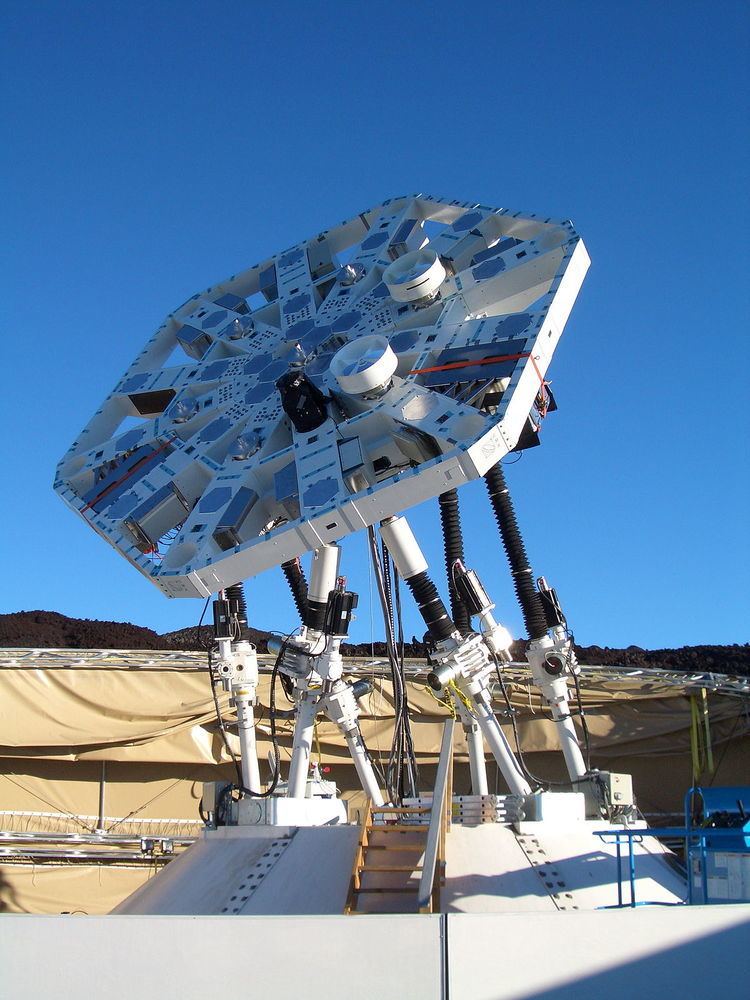Altitude 3,396 m (11,142 ft) Built 2000–2006 (2000–2006) | Wavelength 3 millimetre First light September 2006 | |
 | ||
Telescope style radio telescope, radio interferometer | ||
Amiba amoeba
The Yuan-Tseh Lee Array for Microwave Background Anisotropy, also known as the Array for Microwave Background Anisotropy (AMiBA), is a radio telescope designed to observe the cosmic microwave background and the Sunyaev-Zel'dovich effect in clusters of galaxies. It is located on Mauna Loa in Hawaii, at 3,396 metres (11,142 ft) above sea level.
Contents
AMiBA was originally configured as a 7-element interferometer atop a hexapod mount. Observations at a wavelength of 3 mm (86–102 GHz) started in October 2006, and the detections of six clusters by the Sunyaev-Zel'dovich effect were announced in 2008. In 2009 the telescope was upgraded to 13 elements, and it is capable of further expansion to 19 elements. AMiBA is the result of a collaboration between the Academia Sinica Institute of Astronomy and Astrophysics, the National Taiwan University and the Australia Telescope National Facility, and also involves researchers from other universities.
Amiba en fresco qfb omar ru z
Design
AMiBA was initially configured as a 7-element interferometer, using 0.576 m Cassegrain dishes mounted on a 6 m carbon fibre hexapod mount. It is located on Mauna Loa, Hawaii, and observes at 3 mm (86–102 GHz) to minimize foreground emission from other, non-thermal sources. The telescope has a retractable shelter, made from seven steel trusses and PVC fabric.
The receivers are based on Monolithic Microwave Integrated Circuit (MMIC) technology, with low noise amplifiers cooled to 15 K, which have 20 GHz bandwidths and provide 46 dB of amplification. The signals are mixed with a local oscillator to reduce their frequency, prior to correlation with an analog correlator. The system temperatures are between 55 and 75 K.
AMiBA started in 2000, with funding for 4 years from the Cosmology and Particle Astrophysics Project of the Taiwan Ministry of Education. A 2-element prototype was set up on Mauna Loa in 2002. Further funding for a second 4 years was provided by the National Science Council. The mount arrived on site in 2004, and the platform was installed in 2005. The first 7 elements were then installed ("AMiBA7"), and the telescope's first light was in September 2006, observing Jupiter. The telescope was dedicated in October 2006 to Yuan-Tseh Lee. The array was upgraded to have thirteen 1.2 m dishes in 2009 ("AMiBA13"). After extensive testing and calibration, scientific observations resumed in 2011. It is further expandable up to 19 elements.
Observations
The primary goal of AMiBA is to observe both the temperature and polarization anisotropies in the Cosmic Microwave Background at multipoles between 800 and 8,000 (corresponding to between 2 and 20 arcminutes on the sky), as well as observing the thermal Sunyaev-Zel'dovich effect in clusters of galaxies, which has a maximum decrement around 100 GHz. In its initial configuration, it measures up to multipoles of 3,000 with a resolution of around 6 arcminutes. The telescope only observes at night during good weather, using planets for calibration.
Six clusters were imaged in 2007: the Abell clusters 1689, 1995, 2142, 2163, 2261 and 2390, which have redshifts between 0.091 and 0.322. For the largest and brightest four of these—Abell 1689, 2261, 2142 and 2390—comparisons were made with X-ray and Subaru weak lensing data to study the cluster layout and radial properties, specifically of the mass profiles and baryon content. It is predicted that AMiBA with either 13 or 19 elements will be able to detect around 80 clusters per year via the SZ effect.
Collaboration
AMiBA is the result of a collaboration between the Academia Sinica Institute of Astronomy and Astrophysics, the National Taiwan University and the Australia Telescope National Facility. It also involves researchers from the Harvard-Smithsonian Center for Astrophysics, the National Radio Astronomy Observatory, the University of Hawaii, the University of Bristol, Nottingham Trent University, the Canadian Institute for Theoretical Astrophysics and the Carnegie-Mellon University.
